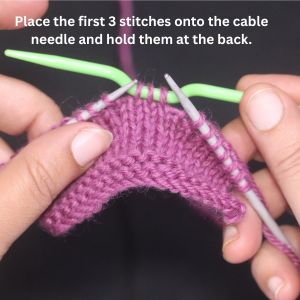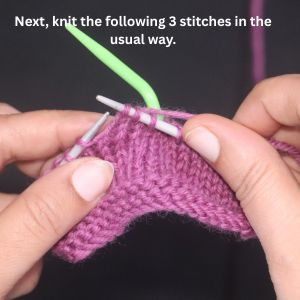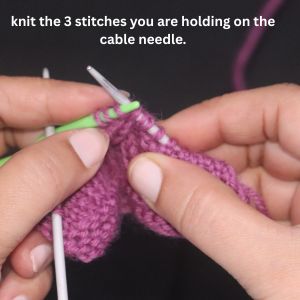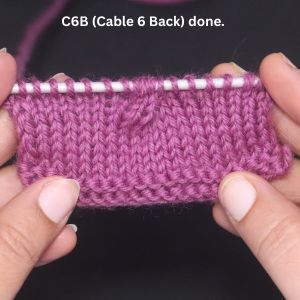Hi friends, and welcome to our new step-by-step tutorial on cable knitting abbreviations!
Today, we’re going to learn about the secret code of knitting—the cool abbreviations used for cable stitches in your favorite beanies and headbands. It might look tricky at first, but once you know the a-b-c’s, you’ll be able to read any knitting pattern like a pro!
Think of a cable stitch as a little braid on your knitting. The abbreviations just tell you how to cross the stitches to make that braid.
How to Read Cable Knitting Abbreviations in Any Pattern
One of the most common knitting abbreviations is C6B (Cable 6 Back). Once you understand this one, you’ll be able to figure out similar cable stitch abbreviations because only the number changes. It’s like learning a secret code for your knitting patterns!
Whenever you see abbreviations like C6B, C4B, C8B, or C10B in your knitting patterns, you can instantly know that the “C” means Cable. This “C” tells you that you’ll be making a cable stitch.
The number in the middle of a cable abbreviation, like 4, 6, 8, or 10, tells you how many total stitches you’ll twist to create the cable. This is a key part of understanding cable abbreviations for your knitting patterns.
The easiest way to figure out how to cable knit is to split the stitches in half.
If the number is 6, you’ll twist 3 stitches over 3 stitches.
If the number is 8, you’ll twist 4 stitches over 4 stitches.
If the number is 10, you’ll twist 5 stitches over 5 stitches.
The letter ‘B’ in knitting abbreviations for cables means to twist the stitches from the back. If you need to make a 6-stitch cable, here is the method:
Note: For cable knitting, a cable needle is required to hold the stitches.
1- Place the first 3 stitches onto the cable needle and hold them at the back.

2- Next, knit the following 3 stitches in the usual way.

3- Then, knit the 3 stitches you are holding on the cable needle

4- C6B (Cable 6 Back) stitch done.

In this way, your cable will be twisted from the back, and you will get the C6B cable.
The number of stitches in a cable knitting project can change, and with it, the cable stitch knitting abbreviations will also change.
For example, when you see C4B, it means your cable uses 4 stitches.
If the cable has 8 stitches, it will be written as C8B.
This is a great tip to help you read and understand knitting patterns more easily!
Now that you’ve learned the cable stitch, you can try a cable project. Let’s check out the cable beanie pattern.
Cable Knitting Abbreviations: C6B Video Tutorial (Step-by-Step)
For your convenience, we’ve also added a video tutorial on how to cable knit.
We hope this post makes cable knitting abbreviations much clearer and easier for you to follow!
FAQ: Understanding Common Cable Knitting Abbreviations (C6B, C4B, etc.)
What does the knitting abbreviation C6B stand for?
C6B stands for Cable 6 Back. It is a common instruction used to create a cable that is worked over six stitches.
What materials do I need to knit a cable stitch?
The most essential material you need for knitting a cable stitch is a Cable Needle.
What is a cable needle used for?
A cable needle is used to temporarily hold stitches while you knit others, helping create the twist in cable knitting patterns.
What’s the best first project with cables?
A simple cable beanie, scarf, or headband is perfect.

Leave a Reply